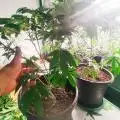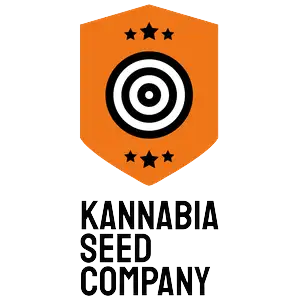The Grow Awards 2026 🏆 

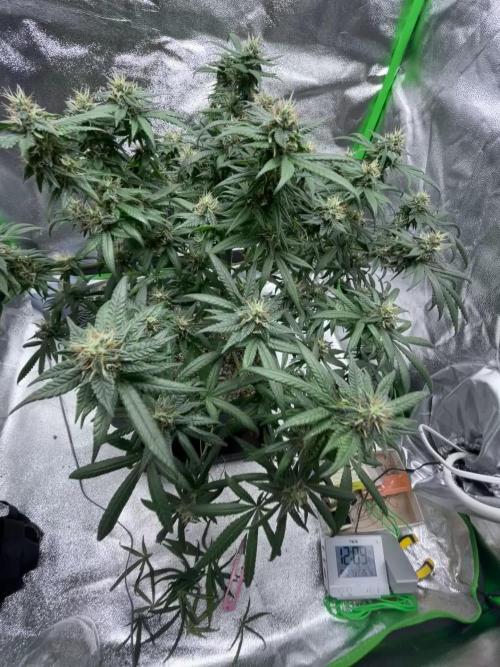
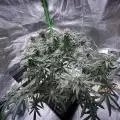




















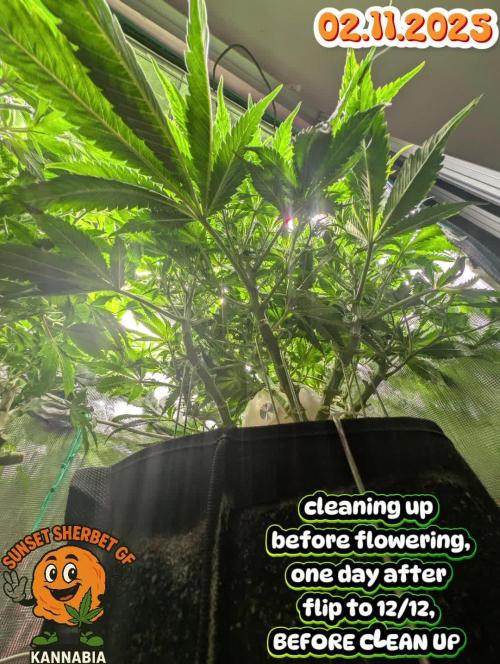





Likes
Comments
Share


@myketb
Follow
Week 1 Day 1
- Clones #1 and #2 are looking alright, not super strong and slight nutrient deficiency issues, but OK. Will just observe for now.
- These clones are currently under a very mild CFL light (20 cm away and about 200 ppfd measured roughly by phone app - Tent Buddy.)
- Clone #3 still need to be covered to maintain moisture. Yesterday I un-cupped the clone and it wilted a lot. This morning it looks better again after a night of rest under the plastic cup.
- I've checked the run off and these clone's pH are so low, while TDS are so high (pH 5.7 and TDS 800pm). This evening, I flushed them with pH 6.5 water and brought the runoff to about pH 6.0 and 350 ppm)
Week 1 Day 2 - Just foliage spray with mild CalMag this morning. Soil is still moist, so no watering.
Week 1 Day 3 - Just minor watering today. Glad to see the clones are doing well as they are growing a bit everyday. Will transfer them to 3 gallon airpots with new soil mix soon.
Week 1 Day 4 - Foliage spray with mild CalMag and Seaweed. Add 5ml of 250 ppm of balanced NPK nutrients AN B52 for each plant.
Week 1 Day 5 - Foliage spray with mild CalMag and Seaweed. Transfer them to 3 gallon airpots.
Week 1 Day 6 - Foliage spray with mild CalMag and Seaweed. Skip watering. The clones responded OK to the new airpots.
Week 1 Day 7 - TBA
Likes
1
Share


@HazeMember
Follow
Blüte Woche 7 aktuell, Härchen zu 60% meinst überall braun und trichome brauchen aber noch um sich überall fertig zu bilden und dann noch milchig zu werden.
Likes
Comments
Share


@Sn3ak92
Follow
Beginning of the week Jan28 D37
Raised intensity of the light at 200w
Watered again at 5.5 to lower the PH
Topped the main stems on the two C&C to lower the canopy. I'm beginning on planning the scrog.
Jan31 D40: Made a good defoliation for a maximum light exposure, a little LST on the KK... This plant is weak since the beginning, slow growth compare to the other 2... Compost tea is brewing for a little boost in available nutrients in 2 days.
I put the trellis net in, let it fill for a week or so before flipping.
Added a tbsp of Gaia green 444 in the two C&C just in case because I'll stay in veg a little longer than I planned
Feb2 D42: fed compost tea, light still at 200w, lowered it a little this week.
Likes
6
Share


@Fleetwood
Follow
Trimmed a few bottom leaves to keep them off the grow medium.
The difference is huge between the plants..... 6 days must have been affected also by more side roots compared to the tap root poking out. I thought it best to let the roots develop in the hydro garden
Processing
Likes
126
Share


@Th3L0rAx
Follow
So.. the flush begins for DD#1 and #2 checking trich’s and these to ladies are showing about 70% clear to 30% cloudy may finish in week nine. DD#3 still in bloom throwing tons of white hairs and purple flowers 100% clear trichs so she’s gonna get another feeding. DD# 4 is the showcase cause not only did she start out slow but she’s the only 1 of the 4 that’s started purple flowers and and is also purple leafed.
I’ll continue to post some picture tonight wanted to get this up as I am flushing and pulling them out of the tent to do so. Also continue to add photo every 2 days.
Updated 4/30 day 58 posted video and some new photos
Day 60 really started to look at trich’s since plants are definitely getting close.
DD#1 looks to be my heaviest producer trich’s are 60/40 no amber yet
DD#2 80/20 no amber
DD#3 90/10 no amber but it must be a mutation or something in the genetics cause it’s no longer thickening up its foxtailing all over so she still got time and we’ll see
DD#4 is looking good and has a few weeks before I’ll start checking trich’s on her, pistols popping white all over the place.
Likes
422
Share


@Crashoverite
Follow
Hi all,
Welcome to my 🍌💜👊 week update.
Thank you so much for your all support on this bananas journey 💜💚💜💚
Week 12
Jan 1 - Jan 7
I am so happy seeing how my girls are developing. All it's going great. 2 waterings of 8ltr on 03/01 no runoff and second on 06/01 9.5ltr! Runoffs PH at 6.2. Purchased larger dehumidifier and installed on 03/01 instantly humidity decreaseed from 55-59 to 50-55 on avg. and at night from 62-69 to 54-60. Light from 01/01 on max power output 110 watts. Nutes slightly adjusted. Buds on both girls gaining size, weight. Trichomes on Athena mostly milky and clear with only very few ambers. Xena mostly 50/50 clear and milky,
They are smelling gorgeously, not sure if I should smoke or eat them first.
Next week will still feed with nutes and keep an eye on trichomes development but it seems that girls are not in a hurry at all. That's okay me neither 😁
Stay tuned for next week entry very soon!
Peace and love brothers and sisters ✌️💚
Links
https://2fast4buds.com/seeds/banana-purple-punch-auto
https://plagron.com
https://www.biobizz.com/
https://fishheadfarms.com/
Likes
15
Share


@Springbokke
Follow
Доброе всем времени суток
Сорт Kerosene Krash от Dutch Passion
Это мой первый репорт за последние 7 лет. И так, с чего бы хотелось начать. Моей растишки сейчас ровно 48 дней, 34 дней как считаю вегу, планирую еще дней 10-14 продержать на веге. На двинатцтый день веги была сломана центровая ветьв(перегнул), стал отталкиваться от новых реалей и решил сформировать такую широкую клону. Для этого я все эти дни гнул боковые стебли, а вчера отрезал у всех боковых их центр(для того чтоб куст тал более широким и его боковые стебли стали более крепкими), кроме одного степбля, не трогал самый слабый. В дальнейшем буду ставить сетку.
Сейчас поливаю через день по 3 литра
Полил ( 607ppm )- 1л Carboload - 2мл/л; 1 день веги
Полил ( 576ppm )- 1л Carboload - 2мл/л; 3 день веги
Полил ( 493ppm )- 1л Carboload - 2мл/л; Piranha - 2мл/л; VooDoo Juice - 2мл/л; Tarantula - 2мл/л; 5 день веги
Полил ( 476ppm )- 1л Carboload - 2мл/л; B-52 - 2мл/л 7 день веги
Полил ( 535 ppm) -3л Carboload - 2мл/л 9 день веги
Полил 3л Cal-mag Xtra - 1мл/л; Sensizym -2мл/л; Carboload - 2мл/л 11 день веги
Полил ( 490ppm )- 3л Carboload - 2мл/л; Piranha - 2мл/л; VooDoo Juice - 2мл/л; Tarantula - 2мл/л; 12 день веги
Полил ( 386ppm )- 3л Carboload - 2мл/л; B-52 - 2мл/л 14 день веги
Полил ( 457ppm )- 3л Carboload - 2мл/л; 16 день веги
Полил 3л Cal-mag Xtra - 1мл/л; Sensizym -2мл/л; Carboload - 2мл/л 18 день веги
Полил ( 537ppm )- 3л Carboload - 2мл/л; Piranha - 2мл/л; VooDoo Juice - 2мл/л; Tarantula - 2мл/л; 20 день веги
Полил ( 688ppm )- 3л Carboload - 2мл/л; B-52 - 2мл/л 22 день веги
Полил ( 551 ppm) -3л Carboload - 2мл/л 24 день веги
Пролил 15 минут под душем 26 день веги
Полил ( 576ppm )- 3л Carboload - 2мл/л; Piranha - 2мл/л; VooDoo Juice - 2мл/л; Tarantula - 2мл/л; 28 день веги
Полил ( 613ppm )- 3л Carboload - 2мл/л; B-52 - 2мл/л 30 день веги
Полил ( 836 ppm) -3л Carboload - 2мл/л 32 день веги
Полил 3л Cal-mag Xtra - 2мл/л; Sensizym -2мл/л; Carboload - 2мл/л 34 день веги
Processing
Likes
16
Share


@iHateSativa
Follow
GSC is basically done, just waiting for 10% amber trichomes
GG4 and Kush look like they'll be while before there ready for harvest
Likes
4
Share


@Daniel_Tri95
Follow
this is the start of the GG4 sherbet FF by 420 fast buds I’m super excited to start this one. I can’t wait to see if there’s any citrus notes in it and remember gave one seed to a buddy
it’s 420 somewhere ™️
Likes
1
Share


@Pierrougarou21
Follow
Yo Growmies
everything is fine.The enter on the 4 weeks is good.Les sites floraux se développent correctement.
Likes
123
Share


@MrHightimes
Follow
Getting there baby! my hope is to feed them GH Ripen next week then flush a week and be done!
______________________________________________________
My friend "The Defoliator" came by and helped me to see even MORE haircuts to give! I think I've set my Defolate schedule to a bit on week 3, alot on week 6 and a little more on 8 or 9.
Buds are looking great and I'm hoping my schedules are going to work!
______________________________________________________
They are drinking it all up and asking for more! Just letting it do its thing at this point!
Likes
6
Share


@CityFarmer
Follow
Hello everyone,
Been busy this week working around the house so not much I can say. Heres a little video of there growing...
See you guys next week
Likes
139
Share


@yan402
Follow
🌸🍊✨🍭🌸🍊✨🍭🌸🍊✨🍭🌸
Back at it with Kannabia — huge thanks for the NEW EXCLUSIVE Upcoming Kannabia's seed Launch 🙏🍨🍊
Grateful for the trust and for everyone following along, I’ll run her clean and showcase what she can do.
Dessert-party goals: berry–citrus sherbet terps, creamy finish, tight stacks, easy trim, zero drama.
Veg 24/0, clean manifold + LST, flip on a happy, even canopy.
Coco’s fresh, seed goes in now. 🚀
Added on 12.10.2025
🌞 Light conditions: Limited direct light for the first 4 weeks — ~4 h/day on weekdays and ~10–11 h on weekends due to tent sharing and work schedule.
🌸🍊✨🍭🌸🍊✨🍭🌸🍊✨🍭🌸
💭❗💭❗💭❗💭❗💭❗💭❗💭
❗Events & thoughts worth noting❗
💭❗💭❗💭❗💭❗💭❗💭❗💭
10.08.25 GW1 Sowed seed, soaked starter pot with #1
12.08.25 GW1 Seed popped hip hip hurray
28.08.25 VW2 Stopped using GreenBuzzBloom, took it out of the schedule.
01.09.25 VW3 TriPartMicro 10→30ml, TriPart bloom 10→30ml
12.09.25 VW4 Applied nemadodes against thrips and fungus gnats.
20.09.25 VW6 topped and trained for first time, decided against a full manifold as I lost a few weeks already.
26.09.25 VW7 Topped her one more time for 8 mains
27.09.25 VW7 Topped up the pot with perlite instead of clay pebbles this time, just trying things out, TriPartMicro 30→40ml , TriPartBloom 30→20ml
10.10.25 VW9 have her a haircut, umm be trimming the side shoots tomorrow, rest in the video 📹
12.10.25 VW9 done some extra trimming to clean up a bit and chose two extra side shoots to nurture info mains, so kept the 8 original mains plus 2 rest in the video 📹
17.10.25 VW9 FfJ/fpj fish mix 30 → 60 ml
20.10.25 VW10 Feed tweak: added 3 g Calcium Nitrate/ 30 L (≈ 15 ppm N + 10 ppm Ca)
24.10.25 VW11 did a defoliation and trimming session 📹
27.10.25 VW11 Epsom Salt 0 → 2.5, Calcium Nitrate 3 → 9 g
01.11.25 VW12 CalMag 60 → 30ml, TriPartBloom 20 → 30ml, Magnesium 2.5 → 3.5g
02.11.25 VW12 Did a cleanup in preparation for flowering, rest in the video 📸
🌱💦🌱💦🌱💦🌱💦🌱💦🌱
🌿 Day to day tasks & actions 🌿
🌱💦🌱💦🌱💦🌱💦🌱💦🌱
31.10.25 VW11 -- no feed no water
01.11.25 VW12 – Fed 5l of #1 → 2l runoff
02.11.25 VW12 – Fed 5l of #1 → 2l runoff
04 11.25 VW12 – Fed 5l of #1 → 2l runoff
05 11.25 VW12 – Fed 5l of #1 → 2l runoff
06.11.25 VW12 – Fed 5l of #1 → 2l runoff
07.11.25 VW12 – Fed 5l of #1 → 2l runoff
(*RUNOFF reused for tomato plants)
💧💦💧💦💧💦💧💦💧
💧 Nutrients in 30 L #1 💧
💧💦💧💦💧💦💧💦💧
💧 TriPart Micro: 10 → 30 → 40 ml
= 0.33 → 1.00 → 1.33 ml/L
💧 TriPart Grow: 0 ml
= 0.00 ml/L
💧 TriPart Bloom: 10 → 30 → 20 → 30 ml
= 0.33 → 1.00 → 0.67 → 1.00 ml/L
💧 Cal-Mag: 60 → 30 ml
= 2.00 → 1.00 ml/L
💧 Home-made FFJ/FPJ (new batch): 30 → 60 ml
= 1.00 → 2.00 ml/L
💧 Calcium Nitrate (Calcinit): 3 → 9 g
≈ 15 → 45 ppm N + 20 → 60 ppm Ca
💧 Magnesium (Epsom Salt / MgSO₄·7H₂O): 0 → 2.5 → 3.5 g
≈ 0 → 8–9 → 11–12 ppm Mg
💧 pH Down: Citric acid (BuxXtrade) — adjust to ~ pH 5.8 – 6.0
📦 TOTAL: ≈ 110 → 180 → 170 → 190 ml liquids
+ 3 → 11.5 → 12.5 g solids per 30 L
≈ 5.9 → 6.4 ml/g active mix per L
💧💦💧💦💧💦💧💦💧
⚙️✂️⚙️✂️⚙️✂️⚙️✂️⚙️
✂️ Tools & equipment ✂️
⚙️✂️⚙️✂️⚙️✂️⚙️✂️⚙️
✂️ 2× MarsHydro SP3000
⚙️ MarsHydro 150mm ACF Ventilator
✂️ Trotec dehumidifier (big unit)
⚙️ Mini no-name dehumidifier
✂️ Kebab skewers (LST – stainless)
⚙️ Wire + roast skewers (LST assist)
✂️ Scissors (HST)
⚙️ Vacuum (for spills & cleanup)
✂️⚙️✂️⚙️✂️⚙️⚙️✂️⚙️✂️⚙️✂️⚙️
---
🍊🍧🌬️🍬🍊🍧🌬️🍬🍊🍧🌬️🍬 Mystery seed (Kannabia Seeds) — NEW EXCLUSIVE
🍊🍧🌬️🍬🍊🍧🌬️🍬🍊🍧🌬️🍬
Species: Hybrid (GF / swift-flowering line)
Genetics: TBA (breeder sheet pending)
THC: TBA
Effect: Euphoric, relaxed, creative (target profile)
Flavor: Berry–citrus sherbet, sweet candy, creamy finish
Flowering (indoors): ~6–7 weeks target (GF)
Resistance: High (aim: no drama)
Indoor yield: TBA
Outdoor yield: TBA
Structure: TBA
Notes: Brand-new exclusive from Kannabia’s GF line — I’ll update specs when the breeder card drops. Goal is rich sherbet terps (berry–citrus + cream), low leaf-to-calyx, easy trim. Stage harvest stays on the table if tops finish early.
YouTube Link: https://youtube.com/-m8h?si=A7x4Zlr2kj-_ga31
Likes
31
Share


@Flauros
Follow
Пережил дефицит Кал-мага и засол почвы почти весь цикл. Справился с этой проблемой, дал не плохой урожай и приятный накур. Реально пахнет конфетами.
Likes
38
Share


@Roberts
Follow
Fruity Pebbles #2 is growing great under the Medic Grow Mini Sun-2. She just started showing her first pistils. So preflowering has started. I dud some aggressive training on her to prepare her for the stretching. The difference between plant 1 and 2 is the nutrition used. This plant is in Athena blended line. Everything is looking great at the moment. She will need a solution change within the next week for blooming nutrition. Thank you ILGM, Athena, and Medic Grow. 🤜🏻🤛🏻🌱🌱🌱 Merry Christmas and Happy Holidays.
Thank you grow diaries community for the 👇likes👇, follows, comments, and subscriptions on my YouTube channel👇. ❄️🌱🍻
Happy Growing 🌱🌱🌱
https://youtube.com/channel/UCAhN7yRzWLpcaRHhMIQ7X4g


